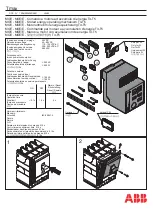
60
Instructions for Installation, Operation and
Maintenance of Magnum SB Insulated Case
Low Voltage Power Circuit Breakers
EATON CORPORATION
www.eaton.com
Instructional Leaflet
IB2C12063H03
Effective March 2012
What To Inspect
What to inspect and to what extent is dictated by the nature of
the maintenance function . Routine inspections require one type
of observation . Inspections following a known high level fault
require more detailed inspections .
A drawout type circuit breaker should first be withdrawn from
its compartment onto the compatment’s extension rails . When
the inspection is complete, the circuit breaker can be levered
to the TEST position to check the electrical operations of the
circuit breaker .
During the levering out and levering in of the circuit breaker, be
aware for any signs that would indicate that this process is not
working properly .
During the inspection of fixed type circuit breakers, bus sys-
tems supplying the fixed circuit breakers should be de-ener-
gized for convenience and safety .
For functional testing of the trip unit, refer to the separate
detailed instruction book dedicated to the trip unit .
Once the circuit breaker has been cleaned as described on
the previous page, visually inspect it for any signs of damage,
missing or loose parts and unusual wear . Be especially alert for
foreign matter that must be removed . On drawout circuit break-
ers, inspect the primary disconnect finger clusters for signs
of wear and erosion . Make appropriate corrections to anything
found out of order .
Table 13. Field Service Tool List
Tool Description
Where Used
10 mm 1/4-inch drive socket
All 6 mm bolts
1/4-inch universal
Mechanism mounting
1/4-inch 6-inch drive extension
As needed
10 mm combination wrench
Primary disconnects
1/4-inch drive ratchet
As needed
3/8-inch drive ratchet
As needed
3/8-inch 17 mm socket
Load conductors
3/8-inch 6-inch extension
Levering-in
17 mm combination wrench
Load conductors
3/8 drive 8 mm or 5/16 long ball driver
Line conductor/arc runner
AMP extraction tool #305183
Secondary contacts
AMP extraction tool #455822-2
Current sensors/shunt trip
#3 Posi-drive screwdriver
Levering-in
#2 Philips screwdriver
As needed
#1 Philips screwdriver
As needed
Long (8-inch) 3/16-inch straight blade
screwdriver
Motor operator installation
7/16-inch combination or adj. wrench
Motor operator stand-off installation
1/4-inch straight blade screwdriver
Rating plug
Pocket size, straight blade screwdriver
Trip unit setting
Eaton test kit and adapter
Digitrip trip unit
It will also be necessary to have a full compliment of standard
field service tools available including, pliers, cutters, soldering
tools, multi-meter, and so on .
Functional Field Testing
NOTICE
BEFORE DOING ANY WORK ON DRAWOUT TYPE CIRCUIT BREAKERS,
MAKE SURE THE BREAKER IS LEVERED OUT TO THE TEST OR
DISCONNECT POSITION. DURING THE LEVERING OUT AND LEVERING
IN OF THE CIRCUIT BREAKER, BE AWARE OF ANY SIGNS THAT
WOULD INDICATE THAT THE LEVERING PROCESS IS NOT WORKING
PROPERLY. IF WORKING ON A FIXED CIRCUIT BREAKER, BUS
SYSTEMS SHOULD BE DE-ENERGIZED FOR CONVENIENCE AND
SAFETY. THE CIRCUIT BREAKER SHOULD BE SWITCHED TO THE OFF
POSITION AND THE MECHANISM SPRINGS DISCHARGED.
Eaton Cutler-Hammer recommends that the following func-
tional tests be performed on Magnum circuit breakers as part
of any maintenance procedure . The circuit breaker should be
removed from service and Cutler-Hammer notified if the circuit
breaker fails to perform any of these tests successfully . Please
be prepared to provide the number of operations the circuit
breaker has to date as well as the following nameplate informa-
tion (
Figure 88
):
A . Low voltage power circuit breaker family name
B . Breaker family designation number
C . Breaker frame size in amperes
D . Interrupting capacity rating
E . Factory Equipped Accessories
Figure 88. SB Nameplate


































